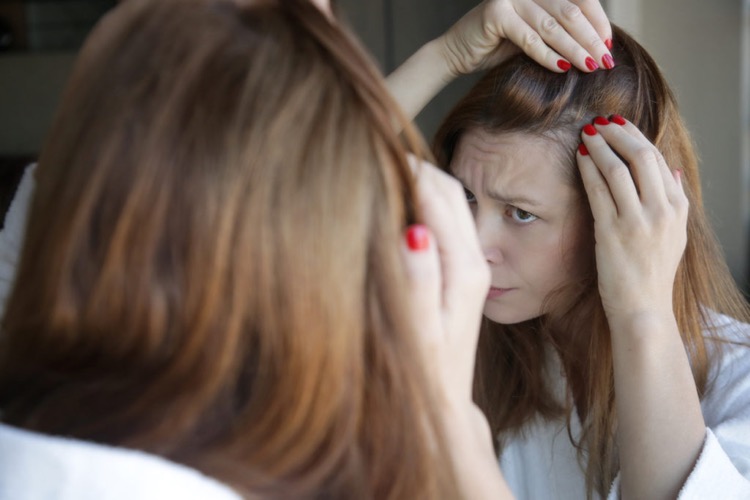Is There a Genetic Test that Can Predict Hair Loss?

Nowadays, there’s a genetic test for just about everything. Even to determine our dog’s lineage. Just one quick saliva sample or blood test and, within days, you can find out if you’re destined for cancer, diabetes, or heart disease. There’s even a DNA test to determine whether you’re likely to experience anxiety.
Suppose a genetic test can give you accurate information to guide your health care plan and prevent future disease. Can it also accurately predict whether you’re predisposed to losing your hair? If a genetic test shows that you are likely to inherit your Great Uncle Bernie or Aunt Bonnie’s hairline, is there a way to ensure that you don’t follow in their footsteps? Are genetic hair tests reliable? Do dermatologists use DNA tests to help make diagnoses? Before you click “Buy Now” to order a genetic test kit, keep reading. We’re here to answer your questions about genetic testing for male and female pattern baldness.
Can Alopecia Really be Inherited?
When people hear the word “alopecia,” they often think of hair loss caused by a medical condition. Types of alopecia such as alopecia areata and lichen planopilaris are caused by autoimmune conditions. Androgenetic alopecia, however, is a type of alopecia that is inherited. It’s the most common type of alopecia. As many as 80 percent of all men will experience male pattern baldness in their lifetime. (01) In addition, many women experience female pattern baldness, usually around menopause.
What’s the Link Between Genetics and Pattern Baldness?
A study conducted on twins confirms what we’ve long suspected. Male and female pattern baldness have a genetic component. (02) About 79 percent of men who were balding in the study could attribute their hair loss to their genes. But, there’s a catch. Researchers are still working to fully understand which genes are affected. We’re still learning. Here’s what we do know. There are 63 genes that could potentially cause baldness. Six of those are associated with the X chromosome, where the Androgen Receptors (AR) are found. It’s also possible that not one isolated gene is the culprit. Several genes working together may be to blame.
Can You Take a DNA Test to Determine Whether You Will Go Bald?
Ads make genetic testing very tempting, especially if your Mom or Dad starts losing their hair in their 20s. It would be nice to know whether you will lose your hair too. But, unfortunately, we’re not quite there yet. As mentioned previously, there are still too many unanswered questions about which genes are involved and how the genetic process affects your locks. Also, false positives are not unusual with genetic testing. You don’t want a test to tell you that you’ll experience androgenetic alopecia if that isn’t really the case. (03)
How do you Know if the Type of Alopecia You Have is Genetic?
When men and women experience androgenetic alopecia, they see specific hair loss patterns. The first sign for men is usually a receding hairline. The hair loss then progresses to the top, creating a horseshoe pattern above your ears that circles around to the back of your head. Female pattern hair loss typically presents differently. Women usually notice thinning on the top and crown. Often, women will notice a widening of the center part. Many other conditions cause hair loss besides androgenetic alopecia. If you think your hair loss is genetic, be sure to have your dermatologist confirm your findings. Early diagnosis is key to preventing further hair loss and to stimulating new growth. You also want to make sure you’re addressing the right condition with the right treatment.
Do Dermatologists Use Genetic Testing to Diagnose Male and Female Pattern Baldness?
The truth is that dermatologists don’t need high-tech tests to determine whether or not patients have androgenetic alopecia. Most of the time, they can tell from your hair’s appearance and your hair loss pattern. If there is any doubt, he or she may use a densitometer to magnify your hair follicles to see if miniaturization is occurring. Miniaturization is when the hair follicles shrink, causing existing hair to fall out and preventing new growth. Your dermatologist may order a biopsy and blood test to rule out other causes. Patients often ask about the benefits of running a hair analysis based on what they hear about on social media. Hair analysis is not used to diagnose male or female pattern baldness. Instead, it’s used to determine whether there’s lead, arsenic, or another substance causing your hair loss.
What Can You Do to Treat Hair Loss Caused by Genetics?
Treatment for male or female pattern baldness is designed to meet two goals. The first is to stop the progression of your hair loss. The second is to promote new hair growth. The best way to accomplish those two goals is by using a combination of medications simultaneously. Here are medications often included in treatment plans for androgenetic alopecia:
- Minoxidil topical foam – A vasodilator that enlarges the hair follicles
- Finasteride, Dutasteride, or Spironolactone – Prevents testosterone from converting to DHT that attacks the hair follicles and causes hair loss
- Topical or oral cortisone – Treats any redness or irritation (not needed for evey patient)
Some men are concerned about experiencing sexual side effects with oral Finasteride. If this is the case, topcial Finasteride has been proven to be just as effective without the side effects. (04) Even better, topical solutions which mix Finasteride with Minoxidil, Cortisone and Retinol offer an even more effective all-in-one solution. The retinol improves absorption of the other three medications.
Are There Other Causes of Hair Loss Besides Genetics?
Male and female pattern hair loss are the only types of genetically induced alopecia. However, other types of alopecia exist and treatment plans are designed to treat the type of alopecia you are experiencing. Examples of other types of alopecia include:
- Temporary Alopecia (Telogen Effluvium) – Occurs due to sudden illness, stress, or shock and usually reverses itself without treatment
- Autoimmune Alopecia (Alopecia Areata and Lichen Planopilaris) – People experience flares and periods of remission
- Trauma-induced Alopecia (Traction Alopecia and Trichotillomania) – Alopecia results from hairstyles that pull on the hair follicles or when people pull out their hair as a stress response)
Can You Prevent Hereditary Hair Loss?
Let’s play pretend for a minute. Let’s say that a genetic test does exist that will determine whether or not you will lose your hair. The tests come back showing that you are genetically predisposed to androgenetic alopecia. Is there a way to prevent hair loss before it begins? Sure, eating right, exercising, and managing stress never hurt. But, even with that, you can’t necessarily fight Mother Nature. That would be nice, though. If male or female pattern baldness does rear its head, then it’s time to take action.
Can You Reverse Hereditary Hair Loss
If you’re experiencing male or female pattern baldness and want to learn more about products available, contact us. Although there isn’t a way to prevent androgenetic alopecia from occuring in the first place, there are things you can do to reverse the condition. Minoxidil, Finasteride and other medications have been found to be safe and effective. Our board-certified dermatologists and hair specialists are available to answer your questions and help you develop the ideal treatment plan for your needs and lifestyle.
Resources:
(01) https://www.ncbi.nlm.nih.gov/books/NBK538178/
(02) https://academic.oup.com/biomedgerontology/article/60/8/1077/545174
(03) https://www.nature.com/articles/gim201838
(04) https://www.ncbi.nlm.nih.gov/pmc/articles/PMC6609098/



